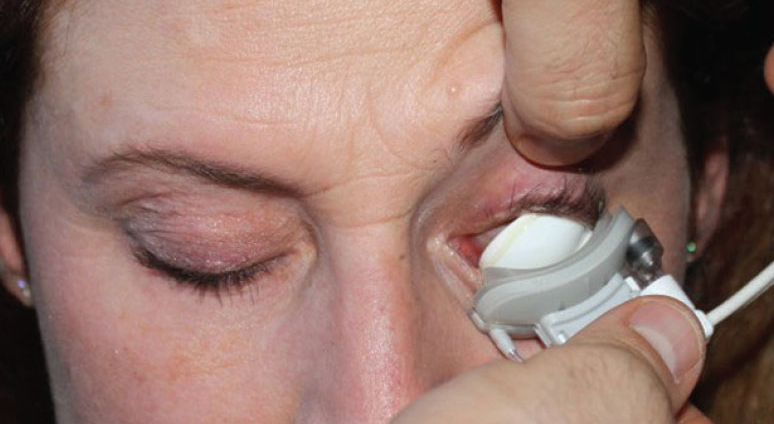 |
| While research validates the safety and efficacy of thermal pulsation for the treatment of MGD and dry eye, the durability and long-term effects warrant further investigation. Photo: Katherine Sanford, OD. Click image to enlarge. |
Researchers report, in a new Ophthalmic Technology Assessment by the American Academy of Ophthalmology, on a literature review to evaluate the safety and efficacy of an increasingly popular treatment for meibomian gland dysfunction (MGD)—thermal pulsation—alongside conventional therapies, such as warm compresses and eyelid hygiene. The team found that the intervention can improve subjective and objective parameters of MGD and dry eye after a single session, though treatment durability and long-term benefits remain unclear.
In each of the 11 studies included in the review, participants underwent single, 12-minute sessions using the LipiFlow automated thermal pulsation system (J&J). Controls were treated with lid hygiene or warm compress therapy.
Throughout the first 12 months after thermal pulsation treatment, patients showed improvement in both subjective and objective metrics of MGD and dry eye compared with controls. Nine of 11 studies reported greater efficacy with thermal pulsation than with standard warm compress therapy and eyelid hygiene, although it’s important to note that four of these studies had relevant industry conflicts of interest.
“Patients from predominately White or Asian populations experienced both subjective benefits (as measured by validated questionnaires) and objective improvement in the health of the eyelids and ocular surface compared with nontreatment for several months after a single thermal pulsation session,” the researchers reported in their study, published in Ophthalmology.
Regarding safety, the procedure passed with flying colors in all 11 studies, none of which reported any serious adverse events.
While this literature review only evaluated patients with up to one year of follow-up, further research will be needed to assess the durability of thermal pulsation in patients with MGD or dry eye, the authors suggest. “Independent, unbiased studies of different thermal pulsation treatment frequencies and controlled studies of other thermal pulsation platforms in diverse populations are warranted,” they wrote, adding that devices other than LipiFlow should also be assessed.
The team concluded in their paper that, based on the current evidence, “Thermal pulsation seems to be safe and may add to the therapeutic armamentarium for MGD and dry eye, and it may fill a void if regimented eyelid hygiene and warm compress therapy are not possible or not desirable.”
Tao JP, Shen JF, Aakalu VK, et al. Thermal pulsation in the management of meibomian gland dysfunction and dry eye: a report by the American Academy of Ophthalmology. Ophthalmology. August 27, 2023. [Epub ahead of print]. |

